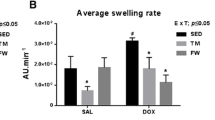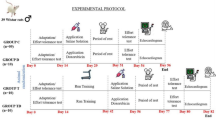Abstract
Doxorubicin (DOX) is a potent and widely used antineoplastic agent. Despite the efficacy of DOX, its clinical use is limited by a dose-dependent cardiotoxicity. Chronic exercise training has been shown to protect against DOX-induced cardiotoxicity. It is less clear whether short-term exercise can attenuate DOX-induced dysfunction. The purposes of this study were to determine if short-term wheel running and treadmill exercise training can attenuate the cardiac dysfunction that accompanies DOX treatment and to investigate possible mechanisms that may be involved with any protective effects of exercise. Male Sprague-Dawley rats engaged in a short-term 5-day voluntary wheel running (WR) or treadmill exercise (TM) regimen. Following the exercise preconditioning period, animals received either 10 or 15 mg/kg of DOX or an equivalent volume of saline (SAL). Five days after DOX/SAL exposure, cardiac function was examined. Western immunoblotting was used to quantify left ventricular sarcoendoplasmic reticulum calcium-ATPase 2a (SERCA2a) protein expression. Exercise preconditioning attenuated in vivo and ex vivo cardiac dysfunction observed with DOX treatment alone. Specifically, short-term treadmill exercise (TM + DOX10, 56 ± 4 %; TM + DOX15, 48 ± 5 %) and voluntary wheel running (WR + DOX10, 51 ± 5 %; WR + DOX15, 45 ± 3 %) consistently preserved fractional shortening when compared to sedentary (SED) animals treated with DOX (SED + DOX10, 48 ± 4 %; SED + DOX15, 39 ± 6 %). Likewise, both exercise protocols preserved left ventricular developed pressure (TM + DOX10, 115 ± 6 mmHg; TM + DOX15, 85 ± 5 mmHg; WR + DOX10, 92 ± 12 mmHg; WR + DOX15, 91 ± 8 mmHg) when compared to SED animals treated with DOX (SED + DOX10, 79 ± 6 mmHg; SED + DOX15, 69 ± 7 mmHg). SERCA2a expression was also preserved in TM + DOX and WR + DOX. These findings suggest that short-term exercise prior to DOX treatment may be a valuable adjuvant therapy to offset acute cardiotoxicities and that maintaining calcium handling in cardiomyocytes may be responsible, in part, for the preservation in cardiac function.




Similar content being viewed by others
References
Ascensão A, Ferreira RM, Oliveira PJ, Magalhães J (2006) Effects of endurance training and acute doxorubicin treatment on rat heart mitochondrial alterations induced by in vitro anoxia-reoxygenation. Cardiovasc Toxicol 6:159–171
Ascensão A, Lumini-Oliveira J, Machado NG, Ferreira RM, Goncalves IO, Moreira AC, Marques F, Sardao VA, Oliveira PJ, Magalhães J (2011) Acute exercise protects against calcium-induced cardiac mitochondrial permeability transition pore opening in doxorubicin-treated rats. Clin Sci (Lond) 120:37–49
Ascensão A, Magalhães J, Soares JM, Ferreira R, Neuparth MJ, Marques F, Oliveira PJ, Duarte JA (2012) Moderate endurance training prevents doxorubicin-induced in vivo mitochondriopathy and reduces the development of cardiac apoptosis. Am J Physiol 289:H722–H731
Bradford MM (1976) A rapid and sensitive method for the quantitation of microgram quantities of protein utilizing the principle of protein-dye binding. Anal Biochem 72:248–254
Chicco AJ, Schneider CM, Hayward R (2006) Exercise training attenuates acute doxorubicin-induced cardiac dysfunction. J Cardiovasc Pharmacol 47:182–189
Chicco AJ, Schneider CM, Hayward R (2005) Voluntary exercise protects against acute doxorubicin cardiotoxicity in the isolated perfused rat heart. Am J Physiol Regul Integr Comp Physiol 289:424–431
Chicco AJ, Hydock DS, Schneider CM, Hayward R (2006) Low-intensity exercise training during doxorubicin treatment protects against cardiotoxicity. J Appl Physiol 100:519–527
de Waard MC, van der Velden J, Boontje NM, Dekkers DH, van Haperen R, Kuster DW, Lamers JM, de Crom R, Duncker DJ (2009) Detrimental effect of combined exercise training and eNOS overexpression on cardiac function after myocardial infarction. Am J Physiol Heart Circ Physiol 296:1513–1523
Demirel HA, Powers SK, Zergeroglu MA, Shanely RA, Hamilton K, Coombes J, Naito H (2001) Short-term exercise improves myocardial tolerance to in vivo ischemia-reperfusion in the rat. J Appl Physiol 91:2205–2212
French JP, Hamilton KL, Quindry JC, Lee Y, Upchurch PA, Powers SK (2008) Exercise-induced protection against myocardial apoptosis and necrosis: MnSOD, calcium-handling proteins, and calpain. FASEB J 22:2862–2871
Hamilton KL, Powers SK, Sugiura T, Kim S, Lennon S, Tümer N, Mehta JL (2001) Short-term exercise training can improve myocardial tolerance to I/R without elevation in heat shock proteins. Am J Physiol Heart Circ Physiol 281:1346–1352
Hanna AD, Lam A, Tham S, Dulhunty AF, Beard NA (2014) Adverse effects of doxorubicin and its metabolic product on cardiac RyR2 and SERCA2A. Mol Pharmacol 86:438–449
Harris MB, Starnes JW (2001) Effects of body temperature during exercise training on myocardial adaptations. Am J Physiol Heart Circ Physiol 280:2271–2280
Hydock DS, Lien CY, Schneider CM, Hayward R (2008) Exercise preconditioning protects against doxorubicin-induced cardiac dysfunction. Med Sci Sports Exerc 40:808–817
Hydock DS, Lien CY, Jensen BT, Schneider CM, Hayward R (2011) Exercise preconditioning provides long-term protection against early chronic doxorubicin cardiotoxicity. Integr Cancer Ther 10:47–57
Hydock DS, Lien CY, Jensen BT, Schneider CM, Hayward R (2013) Switching to a low-fat diet attenuates the intensified doxorubicin cardiotoxicity associated with high-fat feeding. Cancer Chemother Pharmacol 71:1551–1560
Iarussi D, Pisacane C, Indolfi P, Casale F, Martino V, Di Tullio MT (2005) Evaluation of left ventricular function in long-term survivors of childhood Hodgkin disease. Pediatr Blood Cancer 45:700–705
Jensen BT, Lien CY, Hydock DS, Schneider CM, Hayward R (2013) Exercise mitigates cardiac doxorubicin accumulation and preserves function in the rat. J Cardiovasc Pharmacol 62:263–269
Kavazis AN, Smuder AJ, Powers SK (2014) Effects of short-term endurance exercise training on acute doxorubicin-induced FOXO transcription in cardiac and skeletal muscle. J Appl Physiol 117:223–230
Kavazis AN, Smuder AJ, Min K, Tümer N, Powers SK (2010) Short-term exercise training protects against doxorubicin-induced cardiac mitochondrial damage independent of HSP72. Am J Physiol Heart Circ Physiol 299:1515–1524
Lambert MI, Noakes TD (1990) Spontaneous running increases VO2max and running performance in rats. J Appl Physiol 68:400–403
Minotti G, Menna P, Salvatorelli E, Cairo G, Gianni L (2004) Anthracyclines: molecular advances and pharmacologic developments in antitumor activity and cardiotoxicity. Pharmacol Rev 56:185–229
Moraska A, Fleshner M (2001) Voluntary physical activity prevents stress-induced behavioral depression and anti-KLH antibody suppression. Am J Physiol Regul Integr Comp Physiol 281:484–489
Moraska A, Deak T, Spencer RL, Roth D, Fleshner M (2000) Treadmill running produces both positive and negative physiological adaptations in Sprague–Dawley rats. Am J Physiol Regul Integr Comp Physiol 279:1321–1329
Mouli S, Nanayakkara G, AlAlasmari A, Eldoumani H, Fu X, Berlin A, Lohani M, Nie B, Arnold RD, Kavazis A, Smith F, Beyers R, Denney T, Dhanasekaran M, Zhong J, Quindry J, Amin R (2015) The role of frataxin in doxorubicin mediated cardiac hypertrophy. Am J Physiol Heart Circ Physiol. doi:10.1152/ajpheart.00182.2015
Murlasits Z, Lee Y, Powers SK (2007) Short-term exercise does not increase ER stress protein expression in cardiac muscle. Med Sci Sports Exerc 39:1522–1528
Natali AJ, Wilson LA, Peckham M, Turner DL, Harrison SM, White E (2002) Different regional effects of voluntary exercise on the mechanical and electrical properties of rat ventricular myocytes. J Physiol 541:863–875
Natali AJ, Turner DL, Harrison SM, White E (2001) Regional effects of voluntary exercise on cell size and contraction-frequency responses in rat cardiac myocytes. J Exp Biol 204:1191–1199
Pillai V, Samant S, Kim G, Gupta M (2015) SIRT3 blocks doxorubicin induced cardiac hypertrophic response by suppressing ROS synthesis from mitochondria. J FASEB 29:977
Quindry J, French J, Hamilton K, Lee Y, Mehta JL, Powers S (2005) Exercise training provides cardioprotection against ischemia-reperfusion induced apoptosis in young and old animals. Exp Gerontol 40:416–425
Scott JM, Khakoo A, Mackey JR, Haykowsky MJ, Douglas PS, Jones LW (2011) Modulation of anthracycline-induced cardiotoxicity by aerobic exercise in breast cancer: current evidence and underlying mechanisms. Circulation 124:642–650
Singal PK, Li T, Kumar D, Danelisen I, Iliskovic N (2000) Adriamycin-induced heart failure: mechanism and modulation. Mol Cell Biochem 207:77–86
Smuder AJ, Kavazis AN, Min K, Powers SK (2013) Doxorubicin-induced markers of myocardial autophagic signaling in sedentary and exercise trained animals. J Appl Physiol 115:176–185
Starnes JW, Choilawala AM, Taylor RP, Nelson MJ, Delp MD (2005) Myocardial heat shock protein 70 expression in young and old rats after identical exercise programs. J Gerontol A Biol Sci Med Sci 60:963–969
Taylor RP, Harris MB, Starnes JW (1999) Acute exercise can improve cardioprotection without increasing heat shock protein content. Am J Physiol 276:1098–1102
Wisloff U, Loennechen JP, Falck G, Beisvag V, Currie S, Smith G, Ellingsen O (2001) Increased contractility and calcium sensitivity in cardiac myocytes isolated from endurance trained rats. Cardiovasc Res 50:495–508
Wisloff U, Helgerud J, Kemi OJ, Ellingsen O (2001) Intensity-controlled treadmill running in rats: VO(2 max) and cardiac hypertrophy. Am J Physiol Heart Circ Physiol 280:1301–1310
Wonders KY, Hydock DS, Schneider CM, Hayward (2008) Acute exercise protects against doxorubicin cardiotoxicity. Integr Cancer Ther 7:147–154
Yano H, Yano L, Kinoshita S, Tsuji E (1997) Effect of voluntary exercise on maximal oxygen uptake in young female fischer 344 rats. Jpn J Physiol 47:139–141
Zucchi R, Danesi R (2003) Cardiac toxicity of antineoplastic anthracyclines. Curr Med Chem Anticancer Agents 3:151–171
Acknowledgments
This work was supported by funds provided by the University of Northern Colorado Sponsored Programs Office to Reid Hayward.
Conflict of interest
The authors do not have any conflicts of interest or professional relationships with companies or manufacturers who would benefit from the results of this study.
Author information
Authors and Affiliations
Corresponding author
Rights and permissions
About this article
Cite this article
Lien, CY., Jensen, B.T., Hydock, D.S. et al. Short-term exercise training attenuates acute doxorubicin cardiotoxicity. J Physiol Biochem 71, 669–678 (2015). https://doi.org/10.1007/s13105-015-0432-x
Received:
Accepted:
Published:
Issue Date:
DOI: https://doi.org/10.1007/s13105-015-0432-x




